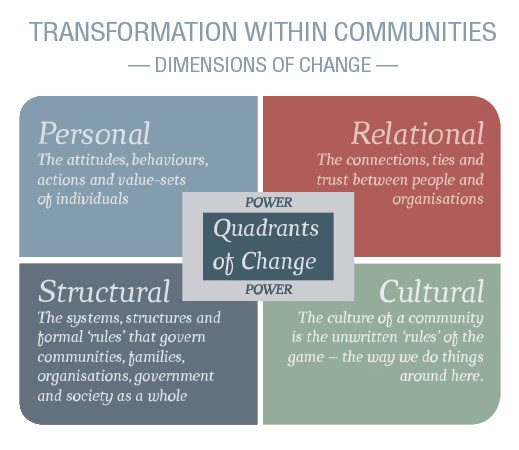The Quadrants of Change Framework
To achieve sustainable change in communities, there are four key dimensions of change to consider: personal, relational, structural and cultural. Any successful and lasting community-change work needs to tap into each area over the course of the change process. Power is another element that has a significant impact on this process, as it influences what and how things happen in communities. This sits at the centre of the diagram and interacts with all other areas.

Diagram adapted from “Reflective Peacebuilding: A Planning, Monitoring, and Learning Toolkit” by J.P. Lederach, R. Neufeldt and H. Culbertson (2007)
One-off or smaller gradual changes may, over time, create the conditions for significant change in communities. What we think of as the ‘little things’ we do are often actually the seeds of ‘big things’ changing. However, it’s important to note that, in isolation, these one-off changes do not create stronger, more resilient communities. Each dimension of change needs to be considered and included. So this framework is really useful in helping us think about what else might need our attention and who in our communities and networks can focus on which bits.
Here are six questions to help you get started using this framework:
- To achieve the transformation you want in your community, what would change look like in each of the four quadrants?
- In which of the four quadrants do you focus most of your energy at the moment?
- Which is the hardest quadrant to work with at the moment, and why?
- Ideally, where do you need to focus your energy in the medium term to achieve the transformation you want?
- How can you model the change you want to see in your community in how you work?
- Who or what other resources could you access to help you with this work?
If you’d like to dig deeper into the Quadrants of Change framework, here’s a reflective inquiry tool that will help. The Leadership as Learning framework below offers more reflective questions about each of these four dimensions of change, to help you consider what needs attention in your CLD mahi.
Ngā Mātāpono/CLD Principles
Implementing all CLD principles at once is sometimes simply not possible, especially when you’re first starting out. What matters is starting from where you, your organisation or community are at and then applying a CLD framework to guide how things develop.
1. Grow from shared local visions
Learn about tāngata whenua, their history and aspirations
Understand who was in this place, who is in this place and who will be in this place.
Build plans with those who live, work, care, play, and invest in a place – the principle of te ahi kaa1.
Tailor-make solutions that reflect local ambitions, goals and contexts.
Grow a shared sense of optimism and collective ownership of the future.
2. Build from strengths
Everyone has a contribution to make.
Value residents as ‘experts’ in their place.
Proactively involve people who are frequently ignored.
Recognise the strengths tāngata whenua bring and build respectful relationships.
Value community assets. Use what you’ve got to help get what you want.
3. Work with diverse people and sectors
Foster connections between groups who don’t usually work together.
Support the aspirations of local whānau, hapū and iwi.
Ensure residents are actively involved in all aspects.
Build relationships between neighbours.
Encourage networking between community-led initiatives locally, regionally and nationally.
4. Grow collaborative local leadership
Seek leadership from across the community – everyone is a potential leader.
Value different cultural approaches to leadership.
Support local people who are doing things and connect them to others to grow their effectiveness.
Invest in developing skills and capacity of local leaders.
Celebrate local leaders and community achievements.
5. Learn by doing
Plan and work adaptively.
Build in time for structured reflection to understand what’s working and what’s not.
Use data and insights to measure impact. Document and share progress widely.
Embrace small steps that contribute to transformational change.
Use local practice-informed evidence to support system changes locally and nationally.
Download our five core principles in full – share these resources amongst your networks and CLD peers.
